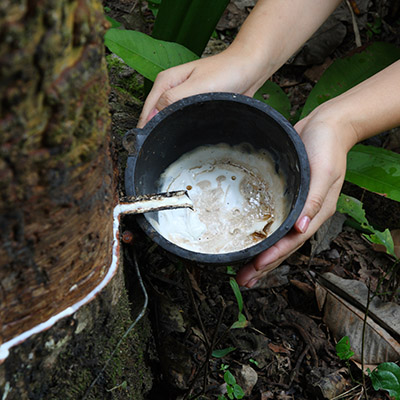Seringa at a glance
- Hardest plantation wood on earth
- Planted and cultivated by small family farmers
- Stores up to 10 tons of CO2 (carbon) per acre in a year
- Produces latex sap for 25 years used in tires, medical and technical products (seals, etc.)
- Trees harden over time. Latex productions slows down and trees replaced by new ones
- Seringa works well with hand and machine tools and takes stain and colors well
CO2 absorption
Estimate per acre, per year
10 year old trees: 10 tons per year
25 year old trees: 6 tons per year
The trees absorb less carbon as they age. Carbon absorption is increased by cutting and replanting.
Other Names: Hevea, Rubberwood, Plantation Hardwood, Para Rubbertree, Sharinga tree, Arbol de caucho, Sibi-sibi, Mapalapa, Seringuera, Capi, Jeve
Description: Seringa (Hevea) is a light-colored medium-density tropical hardwood
Janka Hardness: 960 – 1,050 pounds
Strength (MOR): 10,420 psi
Stiffness (MOE): 1,314 1000 psi
Density (KG/m3): 595
Tangential Shrinkage: 5.1%
Radial Shrinkage: 2.3%
Tree Characteristics: Plantation trees generally reach heights of 60 feet.
Color: Heartwood is a light blonde to medium tan color, sometimes with medium brown streaks. Sapwood is not distinct from heartwood.
Photo-sensitivity: Tends to darken slightly with age.
Luster: Low natural luster
Grain: Grain is straight
Texture: Somewhat coarse, open texture
Working Characteristics: Easy to work with both hand and machine tools. Glues, stains, and finishes well.



 Seringa trees produce natural latex. Latex is used to make tires, medical and other scientific products. Natural latex can absorb and release moisture. Today, how the process is managed from latex to flooring is a positive environmental story. Here are the ways this wood is truly eco-friendly:
Seringa trees produce natural latex. Latex is used to make tires, medical and other scientific products. Natural latex can absorb and release moisture. Today, how the process is managed from latex to flooring is a positive environmental story. Here are the ways this wood is truly eco-friendly: